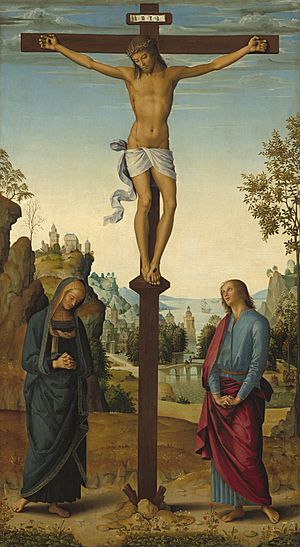Stabat mater facts for kids
The Stabat Mater Dolorosa, often called Stabat Mater, is a very old and famous Catholic hymn. It was written in the 13th century. A hymn is a type of song, usually religious. This hymn is about the deep sadness of Mary, who was Jesus's mother.

Contents
What is the Stabat Mater Hymn?
The name Stabat Mater comes from its first words. This is called an incipit. The first line says "Stabat mater dolorosa". This means "The sorrowful mother stood". The hymn tells the story of Mary standing by the cross. She watches her son, Jesus Christ, being crucified.
The hymn describes Mary's pain and sorrow. It is a powerful poem about a mother's love and loss. Many people believe Jacopone da Todi, a Franciscan friar, wrote it. Some also think Pope Innocent III might have written it.
When is the Stabat Mater Sung?
The Stabat Mater is sung during church services. It is especially important on the memorial of Our Lady of Sorrows. This day remembers Mary's seven sorrows. These sorrows include her pain during Jesus's crucifixion.
The hymn helps people think about Mary's suffering. It is a way to share in her grief. It reminds people of the sacrifices made.
Famous Music for Stabat Mater
Many famous composers have set the Stabat Mater to music. This means they wrote melodies and harmonies for the hymn's words. These musical versions are often beautiful and moving.
Some of the well-known composers include:
- Palestrina
- Pergolesi
- Alessandro Scarlatti
- Domenico Scarlatti
- Vivaldi
- Haydn
- Rossini
- Dvořák
- Poulenc
- Arvo Pärt
Each composer created their own unique version. This shows how inspiring the hymn's words are.
History of the Hymn
The Stabat Mater hymn has a long history in the Catholic Church. In the 16th century, it was added to the Roman missal. This is a book of prayers and readings for Mass.
For a time, it was removed from some church services. However, in the 18th century, it was added back. Today, it is still part of the Roman Gradual. This book contains the music for the Catholic Mass. The current version of the hymn dates from 1973. It is sung on specific days of the year.
See also
 In Spanish: Stabat Mater para niños
In Spanish: Stabat Mater para niños

